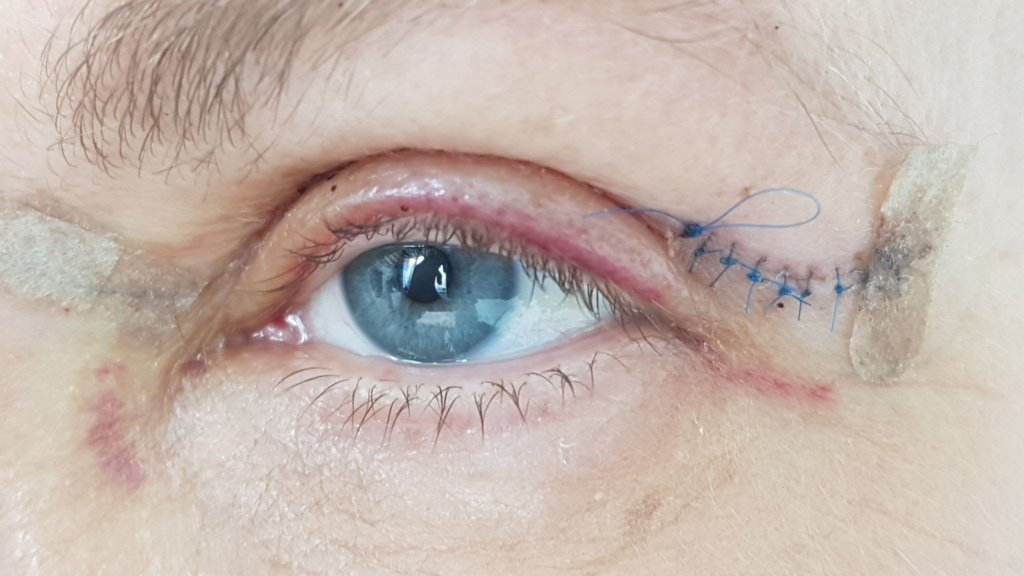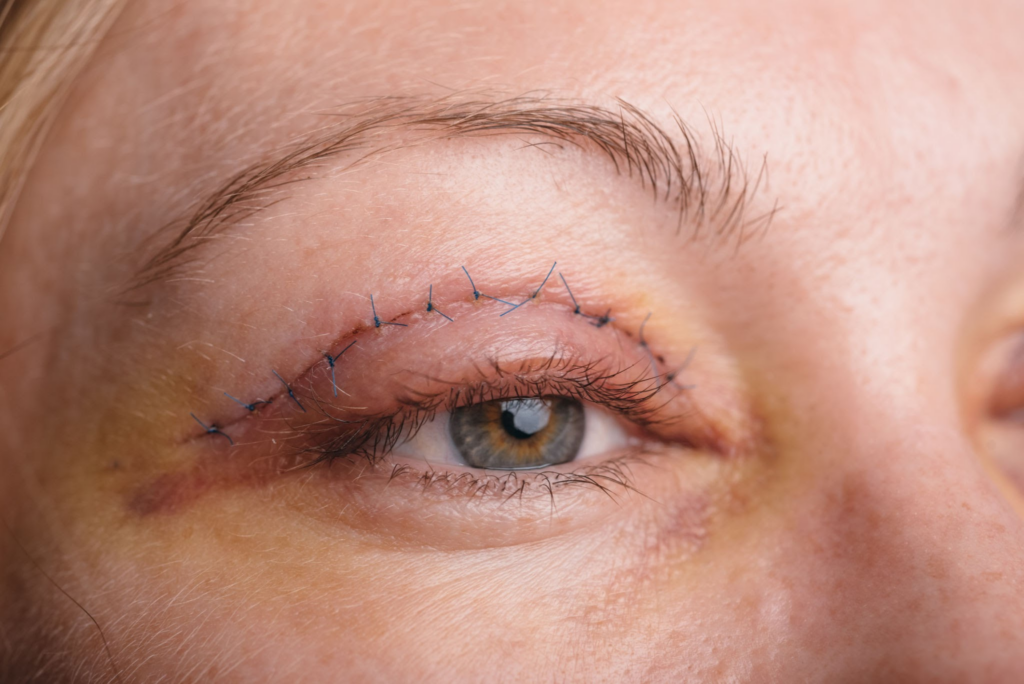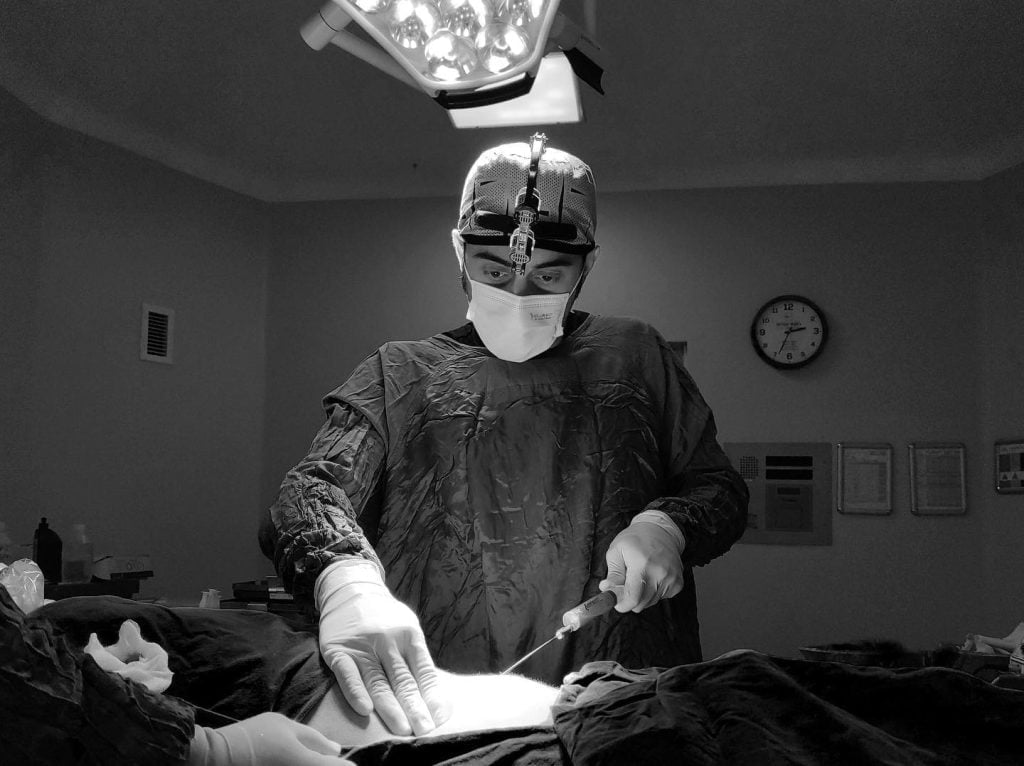This blog post dives into a common concern for many MTF transgender individuals who have undergone eyelid surgery – eyelid retraction. We’ll explore what it is, the potential causes after surgery, and most importantly, whether a procedure called canthal suspension can offer a solution.
Here’s a roadmap for what we’ll cover:
- Understanding Eyelid Retraction and Its Effects
- Unveiling the Causes of Post-Surgical Eyelid Retraction in MTF Transgender Individuals
- Canthal Suspension: A Potential Remedy
- What is Canthal Suspension?
- The Canthal Suspension Procedure Explained (Step-by-Step)
- Canthal Suspension: Benefits and Recovery
- Frequently Asked Questions About Eyelid Retraction and Canthal Suspension
So, if you’re facing this after undergoing eyelid surgery, this blog post might be your beacon of hope!

Table of Contents
Understanding Eyelid Retraction and Its Effects
Eyelid retraction, also known as eyelid lag or upper eyelid retraction, refers to a condition where the upper eyelid fails to completely cover the cornea (the clear front part of your eye) when you look straight ahead. This can cause a variety of symptoms, both aesthetic and functional.
Visually Unsettling:
- One of the most noticeable effects of eyelid retraction is a wider appearance of the eyes. This can be particularly bothersome for MTF transgender individuals who have specifically undergone eyelid surgery to achieve a more feminine look.
- The sclera (the white part of your eye) becomes more visible, sometimes creating an astonished or surprised expression.
Functional Issues:
- Dryness and irritation of the eyes are frequent complaints with eyelid retraction. This is because the exposed cornea dries out more easily without the complete blink coverage.
- Light sensitivity can also occur, making it uncomfortable to be in bright environments.
- In severe cases, incomplete blinking can even lead to corneal ulcers, which are a serious complication requiring prompt medical attention.
Now, let’s delve into the potential causes of eyelid retraction specifically after eyelid surgery in MTF transgender individuals.

Unveiling the Causes of Post-Surgical Eyelid Retraction in MTF Transgender Individuals
Eyelid surgery, also known as blepharoplasty, can be a transformative procedure for MTF transgender women seeking a more feminine appearance. However, in some cases, it can lead to an unintended consequence – eyelid retraction. Here, we’ll explore the potential culprits behind this complication:
- Overzealous Skin Removal: During blepharoplasty, the surgeon removes excess skin from the upper eyelids. If too much skin is removed, it can disrupt the delicate balance of tissues that naturally hold the eyelid in place. This can lead to the upper eyelid being pulled upwards, resulting in retraction.
- Disruption of the Levator Muscle: The levator palpebrae superioris muscle is responsible for lifting the upper eyelid. During surgery, there’s a slight risk of unintentionally weakening or detaching this muscle. This can compromise its ability to properly close the eyelid, leading to retraction.
- Previous Eyelid Conditions: Underlying eyelid conditions like ptosis (drooping eyelid) or thyroid eye disease might require additional surgical maneuvers during blepharoplasty. These procedures can sometimes alter the eyelid structure and contribute to retraction post-surgery.
- Individual Healing Variations: Every person heals differently. In some cases, the natural healing process after blepharoplasty can lead to scar tissue formation. This scar tissue can contract and pull the eyelid upwards, causing retraction.
It’s important to note that not everyone who undergoes eyelid surgery will experience retraction. However, being aware of the potential causes can help you discuss them with your surgeon beforehand and minimize the risk.
Now, let’s explore a potential solution for addressing eyelid retraction – a procedure called canthal suspension.
Canthal Suspension: A Potential Remedy
Eyelid retraction after surgery can be a frustrating complication. Thankfully, there might be a light at the end of the tunnel – a corrective procedure called canthal suspension. Let’s delve deeper into what it is and how it can potentially help.
What is Canthal Suspension?
The canthi (plural of canthus) are the lateral corners of your eyes, where the upper and lower eyelids meet. These corners are anchored to the bones of your skull by strong ligaments called canthal tendons. Canthal suspension is a surgical procedure designed to address eyelid retraction by reinforcing these very canthal tendons.
The Canthal Suspension Procedure Explained (Step-by-Step)
Canthal suspension is typically performed as an outpatient procedure under local anesthesia with sedation. Here’s a simplified breakdown of the steps involved:
- Making the Incision: The surgeon typically makes a small incision near the lateral canthus, carefully avoiding any visible areas.
- Accessing the Canthal Tendon: Through the incision, the surgeon reaches the canthal tendon.
- Reinforcing the Tendon: Various techniques can be employed for reinforcement. One common method involves suturing (stitching) the tendon to a nearby structure like the periosteum (the tough membrane covering the bone). This tightens and strengthens the tendon, preventing the upper eyelid from retracting.
- Closing the Incision: Once the tendon is secured, the surgeon meticulously closes the incision with dissolvable sutures.
Remember: This is a simplified explanation. The exact details of the procedure may vary depending on the individual’s case and the surgeon’s preferred technique.
Canthal Suspension: Benefits and Recovery
If successful, canthal suspension can offer several benefits:
- Reduced Eyelid Retraction: The primary goal is to correct the eyelid retraction, restoring a more natural eyelid position and reducing the amount of exposed sclera.
- Improved Eye Comfort: By addressing retraction, the procedure can alleviate symptoms like dryness, irritation, and light sensitivity.
- Enhanced Appearance: For MTF transgender individuals, achieving a more balanced and feminine eye appearance can be a significant benefit.
Recovery after canthal suspension is generally quick. You might experience some mild swelling and bruising around the eyes for a few days, but these should subside gradually. Discomfort is usually manageable with pain medication. Most patients can return to work and normal activities within a week or so. However, it’s crucial to follow your surgeon’s specific instructions for post-operative care to ensure optimal healing.
It’s important to remember: Canthal suspension is not a one-size-fits-all solution. Consulting a qualified oculoplastic surgeon (an ophthalmologist specializing in eyelid surgery) is essential to determine if you’re a good candidate for this procedure. They will assess your individual situation, the cause of your eyelid retraction, and discuss the potential risks and benefits of canthal suspension in detail.
Frequently Asked Questions About Eyelid Retraction and Canthal Suspension
Now that we’ve explored eyelid retraction and canthal suspension, you might have some lingering questions. Let’s address some of the most commonly asked ones:
1. Can anything be done to prevent eyelid retraction after surgery?
While there’s no guaranteed way to prevent retraction, open communication with your surgeon beforehand is key. Discussing your concerns, medical history, and desired outcomes can help them tailor the surgical plan to minimize the risk.
2. Are there any non-surgical options for treating eyelid retraction?
In some mild cases, artificial tears or lubricating eye drops might offer temporary relief from dryness and irritation caused by retraction. However, these don’t address the underlying cause and won’t correct the eyelid position.
3. What are the potential risks associated with canthal suspension?
As with any surgery, canthal suspension carries some potential risks. These can include bleeding, infection, asymmetry (uneven results in both eyes), and persistent retraction. Discussing these risks in detail with your surgeon is crucial before making a decision.
4. How long do the results of canthal suspension typically last?
Canthal suspension is generally considered a long-lasting solution for eyelid retraction. However, individual factors like healing and aging can influence the results. Consulting your surgeon about long-term expectations is important.
5. Will insurance cover canthal suspension?
Eyelid surgery for purely cosmetic reasons is typically not covered by insurance. However, if your retraction is causing functional problems like corneal ulcers, insurance might offer some coverage for canthal suspension as a corrective procedure. It’s best to check with your insurance provider for specific details.
Remember: This blog post is for informational purposes only and should not be a substitute for professional medical advice. If you’re experiencing eyelid retraction after surgery, consult a qualified oculoplastic surgeon to discuss your individual situation and explore the best course of treatment for you.
Conclusion
Eyelid retraction after surgery can be a frustrating experience for MTF transgender individuals who have undergone blepharoplasty for a more feminine appearance. This condition not only disrupts aesthetics but can also lead to functional problems like dry eyes and light sensitivity.
Thankfully, there’s a potential solution – canthal suspension. This surgical procedure aims to reinforce the canthal tendons, the anchors that hold the eyelids in place, effectively correcting retraction and restoring a natural eyelid position.
The Road to Recovery and Beyond
If you’re considering canthal suspension, remember it’s crucial to consult a qualified oculoplastic surgeon. They can assess your specific situation, determine if you’re a good candidate, and discuss the potential risks and benefits in detail. While recovery is typically quick, following your surgeon’s post-operative instructions diligently is essential for optimal healing.
Beyond the Blog
This blog post has hopefully provided valuable insights into eyelid retraction and canthal suspension. However, it’s just the first step. If you’re experiencing retraction and considering corrective surgery, the next step is to schedule a consultation with a qualified oculoplastic surgeon. They can answer your specific questions, address your concerns, and guide you towards achieving the beautiful and comfortable eyes you deserve.

Why Choose Dr. MFO for Your FTM/MTF Transformation Journey in Turkey?
Your journey towards achieving your authentic self deserves the utmost care and expertise. When it comes to facial feminization surgery (FFS) or female-to-male surgery (FTM), Dr. Mehmet Fatih Okyay (Dr. MFO) stands out as a leading figure in the field.
Dr. MFO’s qualifications and experience speak volumes. Ranked 8th in his term at the prestigious Turkish Medical Specialization Examination, he went on to complete his residency in Plastic, Reconstructive, and Aesthetic Surgery at Istanbul University, Cerrahpaşa Faculty of Medicine – a world-renowned institution.
But what truly sets Dr. MFO apart is his unwavering dedication to achieving exceptional results in facial transformation surgery. This dedication is further solidified by his fellowship – the Fellow of the European Board of Plastic, Reconstructive and Aesthetic Surgeons (FEBOPRAS) – awarded by the European Association of Medical Specialists. This distinguished recognition signifies the quality and expertise that aligns with the highest European standards.
Dr. MFO’s mastery extends beyond accolades. With over 10 years of experience, he has honed his skills in various procedures, including:
- Facial Feminization Surgery (FFS): Here, Dr. MFO excels in achieving subtle yet impactful refinements, like browbone reduction, rhinoplasty (nose job), and canthal suspension for a more feminine eye shape.
- Female-to-Male Surgery (FTM): Dr. MFO understands the importance of a masculinized facial structure. He offers procedures like facial masculinization surgery, chest reconstruction (top surgery), and Adam’s apple augmentation.
Beyond facial transformations, Dr. MFO is a well-rounded surgeon with expertise in body contouring procedures like liposuction and tummy tucks, and breast aesthetics.
A Passionate Artist, a Dedicated Surgeon
Dr. MFO’s artistic background fuels his surgical precision. He approaches each transformation as a unique work of art, ensuring natural-looking results that complement your individual features.
Taking the Next Step
Your journey to self-discovery is personal. Dr. MFO and his team at Dr. MFO Clinic are committed to providing a supportive and understanding environment throughout your consultation and recovery process.
Schedule a consultation today and embark on your transformation journey with confidence.
Visit Dr.MFO Instagram profile to see real patient transformations! Get a glimpse of the incredible results achieved through facial feminization surgery and other procedures. The profile showcases before-and-after photos that highlight Dr. MFO’s expertise and artistic vision in creating natural-looking, beautiful outcomes.
Ready to take the next step in your journey? Schedule a free consultation with Dr. MFO today. During the consultation, you can discuss your goals, ask any questions you may have, and learn more about how Dr. MFO can help you achieve your desired look. Don’t hesitate to take advantage of this free opportunity to explore your options and see if Dr. MFO is the right fit for you.





